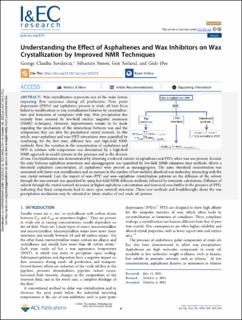| dc.contributor.author | Savulescu, George-Claudiu | |
| dc.contributor.author | Øye, Gisle | |
| dc.contributor.author | Simon, Sebastien Charles Roger | |
| dc.contributor.author | Sørland, Geir | |
| dc.date.accessioned | 2023-11-27T08:28:30Z | |
| dc.date.available | 2023-11-27T08:28:30Z | |
| dc.date.created | 2023-10-30T14:58:49Z | |
| dc.date.issued | 2023 | |
| dc.identifier.citation | Ind. Eng. Chem. Res. 2023, 62, 44 | en_US |
| dc.identifier.issn | 0888-5885 | |
| dc.identifier.uri | https://hdl.handle.net/11250/3104704 | |
| dc.description.abstract | Wax crystallization represents one of the main factors impacting flow assurance during oil production. Pour point depressants (PPDs) and asphaltenes present in crude oil have been linked to modifications in wax crystallization behavior by cocrystallization and formation of complexes with wax. Wax precipitation has recently been assessed by low-field nuclear magnetic resonance (NMR) techniques. However, improvements remain to be made regarding the mechanism of the interactions between wax and the components that can alter the precipitated crystal network. In this article, wax–asphaltene and wax–PPD interactions were quantified by combining, for the first time, different low- and high-field NMR methods. First, the variation in the concentration of asphaltenes and PPD in solution with temperature was determined by a high-field NMR approach in model systems in the presence and in the absence of wax. Cocrystallization was demonstrated by observing a reduced content of asphaltenes and PPDs when wax was present. Second, the ratio between asphaltene monomers and nanoaggregates was quantified by low-field NMR relaxation time methods. Above a threshold asphaltene concentration, all asphaltenes were present as nanoaggregates. The same threshold concentration was associated with faster wax crystallization and an increase in the number of low-mobility dissolved wax molecules, interacting with the wax crystal network. Last, the impact of wax–PPD and wax–asphaltene crystallization patterns on the diffusion of the solvent through the wax network was quantified by using low-field NMR diffusion methods, followed by tortuosity calculations. Diffusion of solvent through the crystal network increased at higher asphaltene concentration and increased even further in the presence of PPD, indicating that these components lead to more open network structures. These new methods and breakthroughs about the wax precipitation mechanism may be extended to future studies of real crude oil systems. | en_US |
| dc.language.iso | eng | en_US |
| dc.publisher | ACS | en_US |
| dc.relation.uri | https://pubs.acs.org/doi/full/10.1021/acs.iecr.3c02218 | |
| dc.rights | Navngivelse 4.0 Internasjonal | * |
| dc.rights.uri | http://creativecommons.org/licenses/by/4.0/deed.no | * |
| dc.title | Understanding the Effect of Asphaltenes and Wax Inhibitors on Wax Crystallization by Improved NMR Techniques | en_US |
| dc.title.alternative | Understanding the Effect of Asphaltenes and Wax Inhibitors on Wax Crystallization by Improved NMR Techniques | en_US |
| dc.type | Journal article | en_US |
| dc.type | Peer reviewed | en_US |
| dc.description.version | publishedVersion | en_US |
| dc.source.journal | Industrial & Engineering Chemistry Research | en_US |
| dc.identifier.doi | 10.1021/acs.iecr.3c02218 | |
| dc.identifier.cristin | 2190118 | |
| dc.relation.project | Norges forskningsråd: 237893 | en_US |
| cristin.ispublished | true | |
| cristin.fulltext | original | |
| cristin.fulltext | preprint | |
| cristin.fulltext | postprint | |
| cristin.fulltext | original | |
| cristin.qualitycode | 2 | |

